All news
Local Knowledge: Opportunity for Students
Friday, June 28, 2013
The Social Policy (Development Studies Masters) class visited LIV-Village on a field trip on 28th May, 2013. Situated in Cottonlands, Verulam, LIV-Village is an organization that seeks to provide 'holistic residential care' for vulnerable children.
Our students are given the opportunity to visit areas which are typical of those that they study.
2013: LIV Village. 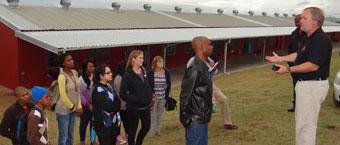
The
Social Policy (Development Studies Masters) class visited LIV-Village
on a field trip on 28th May, 2013. Situated in Cottonlands, Verulam,
LIV-Village is an organization that seeks to provide 'holistic
residential care' for vulnerable children.
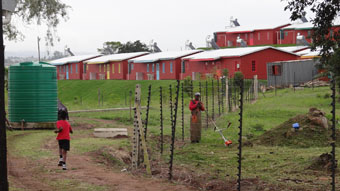
Two
students, Thembi Shangase (Development Studies) and Nthabiseng Marie
(Population Studies) reported on the trip. (For more information see:
http://www.liv-village.com/)
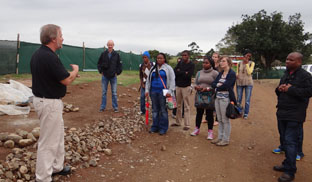 Report from Thembi:
Report from Thembi:
Situated in Cottonlands, Verulam, just a stone’s throw from Tongaat and
Ndwedwe, LIV-Village is an organization that seeks to provide a
'holistic residential care for vulnerable children'. The village is a
product of 'Baba' Tich Smith’s vision, in which he envisioned '10,000
villages, each raising and impacting 500 orphans, ‘the right way’, 5
million children rescued, raised and rebuilt to become future leaders
impacting the continent of Africa, reaching out to other orphans.'
Indeed when entering the village, one is greeted by colourful houses
lacing the 83 acres of hill land upon which first LIV-village is built.
Within
the village there is also a church, pre-school, primary school and a
high school under construction. Upon our arrival we were met by Mark
Emerson, Siya Shange and Alan Beesley, who were later our tour guides
through the village. A brief presentation on LIV’s organisational model
was giving by 'Baba' Smith, followed by a discussion on the recruitment
process for the kids and the mothers, as well as the Social grant system
used to fund each child in the village.
Baba Smith, the founder and
his wife, Joan, who, together have extensive prior experience working
with vulnerable children in the Mawoti area, along with the team at the
village believed that the best way to achieve this holistic social care
is through partnerships between the church, government and business.

Through trained social workers and in collaboration with the department
of Social Services, vulnerable and orphaned children are placed into a
family in the village. Each family consists of a mother and the children
placed under her care; each mother cares for a maximum of six kids. At
the village the children are therefore provided with shelter, a loving
mother, God as the father (spiritual care), nutrition and education. The
village is sustained via LIV–Business which 100% BEE and with all the
proceeds going to the children.
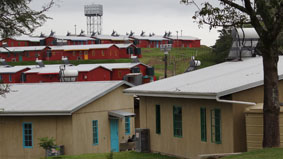
The
foster care grants system is the second mechanism used, which ensures
all the childrens needs are met; proceeds from donors and the LIV-
Banquet are also use to further finance the village. And lastly
corporates make Corporate Social Responsibility (CSI) contributions to
LIV, sponsoring or covering various needs at the village – such as a
computer room, a sports field, a kids play area and various other
voluntary activities.

There aren’t many words one could use to describe the great work that
occurring at the LIV-village, it is all too overwhelming. I would in
fact say it is an ideal model for delivering care for the vulnerable in
the country. What I found striking, was how every single element of the
village was built around sustainability, not only financially but also
environmentally. The village is powered on solar energy, and to each
house in a water tank attached for rain water harvesting. Mark mentioned
at the beginning of our tour that the school building was previously a
chicken shed and that as far as the can possible can they aim to
preserve the old farm buildings on the property.

Alan also highlighted in his presentation that they also partner with
the surrounding community and school in other poverty alleviation
projects. LIV therefore services not only the resident community but
also the Cottonlands community which surrounds them.
This field trip helped put into perspective a lot of the debates we have
in class on social policy and social assistance models. When the team
highlighted some of their challenges and needs, it reminded me of
debates on who is responsible for provision and the mechanism for
provision and the degree to which the state ought to be involved. LIV
for me was proof that you could use capitalism to benefit the poor, and
that business could make incredible contributions to poverty alleviation
in the country; however governance is still a key challenge for most
NPOs & NGOs.
(Thembi Shangase – Development studies Masters Programme)
Report from Nthabiseng 
The
trip to LIV Village afforded us a great opportunity to see how the
practical side of social policy takes shape. Liv Village is colourful
space in an otherwise dull area, beautiful, clean, modern and inviting.
Beyond the aesthetics however is a truly innovative and inspirational
idea that left me with the following thoughts:
· The upliftment of communities is possible with the commitment and
partnership of different stakeholders (private, government and public).
Liv village is an example of such commitment. It is a growing project
with great potential of being replicated locally and internationally.
·
The Liv village project appears as capitalism with a human face. The
owners are committed to working around the capitalist system so that the
beneficiaries of it are ordinary South Africans most at need of social
assistance.
· We can extend ordinary ideas like that of a typical children’s home
into more innovative, brighter spaces that move away from the typical
institutions with white walls and high fences.
· The conservation of the environment and sustainability practices
should be part of our everyday lives and it is never too early to start
learning that valuable lesson.
· Institutions like churches have an important role to play in our communities.
Overall I would say, LIV Village is a reminder that it truly does take a village to raise a child and that the spirit of
ubuntu is still very much alive in South Africa.
(Nthabiseng Marie – Population Studies Masters Programme)
In 2012.... Inchanga Primary 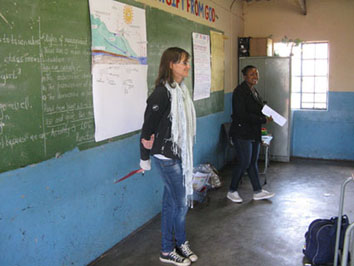 Cathy Sutherland's
Cathy Sutherland's Environment
and Development (Masters in Development Studies) class spent the
morning at Inchanga Primary School. Cathy has long-standing relationship
with the school as part of her ‘Schools as centres of sustainability
research’. Against all odds Mr Shau the headmaster of Inchanga Primary,
and his committed staff, try all kinds of innovative approaches to
address social and environmental issues in the school. The students had
prepared an environmental lesson for the Grade 6 and 7 learners – they
learnt as much from the children about their environment as they ended
up teaching them.
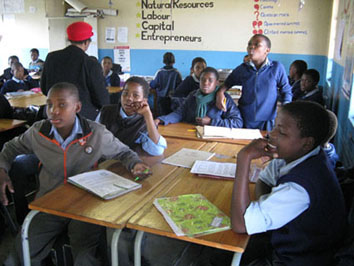
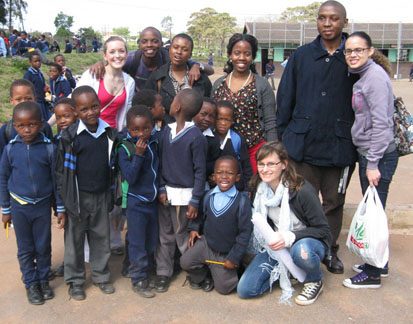
Students on the Development Management coursein years gone byhad the
opportunity to to view several of the projects currently being
undertaken by the Durban Municipality’s Rural Area Based Management
programme. This field trip was a culmination of much of the learning
that had been going on in the classroom. Pictures are from a Hydroponics
Project in Georgedale, and a tourism project in the Valley of a
Thousand Hills.
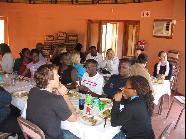


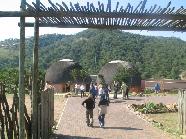
In that year students visited Cato Crest,a section ofCato Manor, where
they were addressed by Umkhumbane Entrepreneurial Support Centre staff,
saw a selection of projects there, and visited a local library.
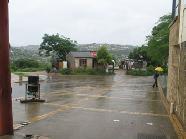
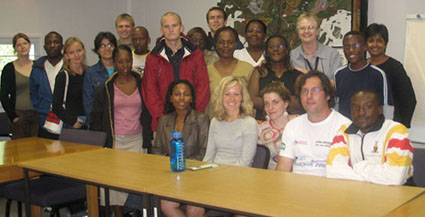 Cato Manor
Cato Manor
Cato Manor is an example of local economic development under the city's
Area-Based Management plan. It has a population of 90,000 and is close
to the city centre. Starting at the offices of the Area-Based
Management, Inthuthuko Junction, students visit the Cato Manor Heritage
Centre,and thentake atour of the area conducted by a local resident,
allowing for stops at key developments nodes along the way. This year
students visited Cato Crest, a large informal settlement, stopped off
atthe recently built Library, and later at the Umkhumbane
Entrepreneurial Support Centre which assists in the development and
incubation of small manufacturing enterprises. Analysis by a planner
from the School of Architecture and Planning concluded the tour.
South Durban
Students also took a 'Toxic tour of south Durban'. Situated close to the
airport South Durban is home to 285,000 people. Surrounded by
industryandthe refinery, residents pay the price of living there with
an increasing number of environmental incidents and illness, as well as
high unemployment. South Durban Community Environmental Alliance
operates this informative tour of the area.
Field Trips










